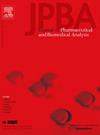Implementation of gas chromatography tandem mass spectrometry for the analysis of six high boiling point polyhydric alcohols in cosmetics and toothpaste based on precolumn derivatization
IF 3.1
3区 医学
Q2 CHEMISTRY, ANALYTICAL
Journal of pharmaceutical and biomedical analysis
Pub Date : 2024-10-03
DOI:10.1016/j.jpba.2024.116503
引用次数: 0
Abstract
Based on precolumn derivatization, an analytical method has been developed for the determination of six high boiling point polyhydric alcohols (HBPAs, b.p. > 300 ℃) in cosmetics and toothpaste, including erythritol, xylitol, Pro-Xylane-S, inositol, mannitol, and sorbitol. The water dispersion and oil in water samples were extracted by distilled water. The water in oil sample was firstly pre-dispersed with acetone, and then extracted by distilled water. The extract was concentrated to dry under nitrogen, and derivatized with acetic anhydride under the dispersion and catalysis of anhydrous pyridine. The derivatives were detected by gas chromatography-tandem mass spectrometry in the selected reaction monitoring mode, and quantified using arabinitol as internal standard. The experimental conditions such as the selection of columns, extraction procedures, and derivative conditions were optimized. This method was properly validated under the optimized conditions, and obtained excellent analytical features. Specifically, the correlation coefficients in the range of 0.02 ∼ 0.5 mg/L all exceed 0.992. The method limits of detection and quantification were 0.25 and 0.8 mg/kg, respectively. The average recoveries in toothpaste, cosmetics with oil in water and water in oil were 81.8 ∼ 107.1 %, with the relative standard deviation were 3.1 ∼ 7.2 %. The established method was successfully applied to commercial samples of different matrices, showing the advantages of simplicity, sensitivity, and good reproducibility, and can be used for the determination of HBPAs in cosmetics and toothpaste. The proposed methodology solves the problem that there is no detection method for HBPAs in cosmetics.
基于柱前衍生化的气相色谱串联质谱法用于分析化妆品和牙膏中的六种高沸点多元醇。
基于柱前衍生化技术,建立了化妆品和牙膏中赤藓糖醇、木糖醇、原木糖烷-S、肌醇、甘露糖醇和山梨醇等6种高沸点多元醇(HBPAs,b.p. > 300 ℃)的分析方法。水分散液和水包油样品由蒸馏水提取。油包水样首先用丙酮预分散,然后用蒸馏水萃取。萃取液在氮气下浓缩至干,在无水吡啶的分散和催化下用乙酸酐进行衍生。衍生物采用气相色谱-串联质谱选择反应监测模式进行检测,并以阿拉伯糖醇为内标进行定量。实验条件,如色谱柱的选择、萃取程序和衍生条件等,都经过了优化。该方法在优化条件下得到了良好的验证,并获得了优异的分析性能。在 0.02 ~ 0.5 mg/L 范围内,相关系数均大于 0.992。方法的检出限和定量限分别为 0.25 和 0.8 mg/kg。在牙膏、水包油化妆品和油包水化妆品中的平均回收率为81.8 ∼ 107.1%,相对标准偏差为3.1 ∼ 7.2%。所建立的方法成功地应用于不同基质的商业样品中,具有简便、灵敏、重现性好等优点,可用于化妆品和牙膏中 HBPAs 的检测。该方法解决了化妆品中 HBPAs 无检测方法的问题。
本文章由计算机程序翻译,如有差异,请以英文原文为准。
求助全文
约1分钟内获得全文
求助全文
来源期刊
CiteScore
6.70
自引率
5.90%
发文量
588
审稿时长
37 days
期刊介绍:
This journal is an international medium directed towards the needs of academic, clinical, government and industrial analysis by publishing original research reports and critical reviews on pharmaceutical and biomedical analysis. It covers the interdisciplinary aspects of analysis in the pharmaceutical, biomedical and clinical sciences, including developments in analytical methodology, instrumentation, computation and interpretation. Submissions on novel applications focusing on drug purity and stability studies, pharmacokinetics, therapeutic monitoring, metabolic profiling; drug-related aspects of analytical biochemistry and forensic toxicology; quality assurance in the pharmaceutical industry are also welcome.
Studies from areas of well established and poorly selective methods, such as UV-VIS spectrophotometry (including derivative and multi-wavelength measurements), basic electroanalytical (potentiometric, polarographic and voltammetric) methods, fluorimetry, flow-injection analysis, etc. are accepted for publication in exceptional cases only, if a unique and substantial advantage over presently known systems is demonstrated. The same applies to the assay of simple drug formulations by any kind of methods and the determination of drugs in biological samples based merely on spiked samples. Drug purity/stability studies should contain information on the structure elucidation of the impurities/degradants.

 求助内容:
求助内容: 应助结果提醒方式:
应助结果提醒方式:


